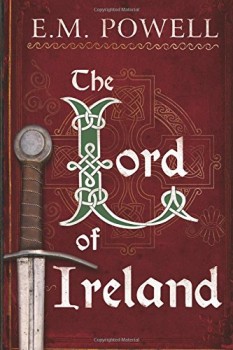The Lord of Ireland by E.M. Powell
Writing Car Chases With Chain Mail
 By Dawn Ius
By Dawn Ius
Put two readers of historical fiction in a room together and within seconds, the accuracy debate will begin. For writers of the genre, this can often lead to the daunting task of dodging ALL CAPS emails condemning everything from perceived inappropriate character depiction to the most minuscule detail—no matter how many sources the author has sourced to back it up.
For E.M. Powell, the author of three medieval thrillers, including THE LORD OF IRELAND, released this month, shouldering the weight of potential historical inaccuracy is just part of the genre—or perhaps, more accurately, part of being an author.
“You see it time after time: authors called out on a detail that’s not correct in legal thrillers, tech thrillers, medical thrillers, police procedurals. Or at least in the opinion of the commenter,” Powell says. “I have had thundering condemnation of things in my books for which I have at least three reputable sources. As for mistakes? Yes, despite my best efforts, I make them from time to time—as does every writer I know.”
Errors appear to be few and far between for Powell, though, as sales for her first medieval thrillers have launched her to a prime spot among her peers—book two in the series, The Fifth Knight became an Amazon UK #1 bestseller in Historical Fiction, and the series has sold more than 100,000 copies.
The key to her success, Powell says, begins with thorough research and ends with scenes that are rich with character—something she struggled with early in her career—and most important for readers of historical fiction, a strong sense of setting.
“Readers of historicals like quite a lot of setting, in much the same way fantasy and science fiction readers do,” she says. “It boils down to the fact that we’re trying to build an unfamiliar world and make it believable.”
It’s different for contemporary authors. Readers don’t need an extensive description of a modern coffee shop, for instance, since they’re more likely focused on the dialogue or action within the scene. Historicals require a little more.
“Not everyone knows what a motte and bailey castle is, for instance,” she says.
Setting is particularly key for THE LORD OF IRELAND, as Powell’s protagonist is a stranger in a strange land. “He’s a 12th century Englishman, and Ireland at the time would have been a largely unknown quantity, a daunting new frontier where things are very different and the native population are out to get the invaders,” she says.
Luckily for Powell—and her fans—she already had an intimate knowledge of the physical landscape in which the novel is set. An Irish native and direct descendant of the influential Irish leader Michael Collins, it would seem Powell was quite literally born to write historical fiction. Add to that her fascination with medieval history—by her definition “the most exciting, extraordinary and, at times, downright bizarre periods in history”—and it makes sense her writing journey would travel along this sometimes ominous path. Not to mention her obvious love of chain mail.
“There may be some eye-rolling at mail as appealing dress from male readers who are possibly envisaging a wimpy Sir Lancelot type,” she says. “But a suit of chain mail and padded armor weighs in at four stone, or fifty-six pounds. You develop a lot of core strength simply wearing it. Wimpy? I don’t think so.”
Like setting, costuming is an important part of historical fiction accuracy, and in addition to a seemingly endless stream of research, Powell looks to her writing idols and mentors for tips on creating historical accuracy.
“For anyone new to historical thrillers, I have to recommend Robert Harris’s Pompeii to start them off,” she says. “C.J. Sansom’s Tudor crime Shardlake series is also remarkable. And speaking of Tudors, The Big Thrill editor Nancy Bilyeau’s suspenseful Joanna Stafford trilogy is right on the money, too.”
But like any story—historical or otherwise—Powell looks to the fundamentals of writing to put together the pieces of each book’s overarching mystery. For instance, the genre requires a suspenseful plot with a crime (or crimes), red herrings, and an eventual solution. Not to mention strong characters, a believable setting, and a “tight, tight plot.”
All of this is clearly evidenced in THE LORD OF IRELAND, a thrilling tale of a medieval king who tries to sort of Ireland by sending in his psycho son for an atrocity that only one loyal knight can (hopefully) stop.
“Or, as my agent would have it in his immortal phrase: the Fifth Knight series is ‘car chases with chain mail,’ ” Powell says.
Fans of her novels will be thrilled to learn there is a fourth book in the research and planning stages, which, if all goes well, will follow the “son” who eventually becomes King John. But Powell is also branching out with a new set of crime books—a Victorian fantasy-steampunk set in the coroner’s office in Manchester.
“It’s darker than the Fifth Knight series,” she says. “But it of course more historical thrills—how could I do anything else?”
Powell’s legion of readers can all echo a collective sigh of relief.
*****
E.M. Powell’s medieval thrillers, The Fifth Knight and The Blood of the Fifth Knight, have been #1 Amazon bestsellers. She reviews fiction and non-fiction for the Historical Novel Society, blogs for English Historical Fiction Authors and is a contributing editor to International Thriller Writers’ The Big Thrill magazine.
Born and raised in the Republic of Ireland into the family of Michael Collins, the legendary revolutionary and founder of the Irish Free State, she lives in north-west England with her husband, daughter and a Facebook-friendly dog.
To learn more about E.M. Powell, please visit her website.
- Africa Scene: Iris Mwanza by Michael Sears - December 16, 2024
- Late Checkout by Alan Orloff (VIDEO) - December 11, 2024
- Jack Stewart with Millie Naylor Hast (VIDEO) - December 11, 2024
